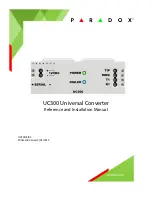
- 14 -
8. FUSES (OR CIRCUIT BREAKERS)
For safety concern, you can connect a DC-rated fuse or a DC-rated circuit breakers on the positive cable line in your power
system, follow these recommendations when you purchasing fuses or circuit breakers.
• Select a fuse or circuit breaker with a maximum rating of 150 Ade.
• Determine the short-circuit current rating of the battery and choose a battery fuse that withstand the short circuit current that may
be generated by the battery.
9. INSTALL THE INVERTER
Review and follow the safety guidelines in “important safety instruction” on page before proceeding with installation.
9.1 OVERVIEW OF INSTALLATION STEPS
• Mount the inverter.
• Connect the chassis ground.
• Connect the DC cables.
9.2 MOUNT THE INVERTER
1. Make sure the inverter’s ON/OFF switch is in the off position.
2. Select an appropriate mounting location and orientation. The inverter must be oriented in one of the following ways:
• Horizontally on a vertical surface. (The ventilation opening on the DC end must not point up or down.)
• On or under a horizontal surface
3. Hold the inverter against the mounting surface, mark the positions of the mounting screws, and then remove the inverter.
4. Pilot drill the four mounting holes.
5. Fasten the inverter to the mounting surface using corrosion-resistant fasteners proper sized. Important: Do not mount the
inverter under the engine hood of a vehicle if you install the inverter on vehicle.
9.3 CONNECT THE CHASSIS GROUND
1. Make sure the inverter’s ON/OFF switch is in the OFF position.
2. Locate the screw terminal labeled chassis ground on the DC panel and remove the chassis ground screw and star washer.
3. Attach the ground cable’s ring connector to the screw terminal on the inverter and secure with the star washer and chassis
ground screw.
4. Attach the other end of the ground cable to the vehicle chassis via a grounding point on the vehicle if you install the
inverter in vehicle. Or attach the other end of the ground cable to the earth If you install inverter for household use.
Danger
ELECTRICAL SHOCK HAZARD
• Never operate the inverter without properly connecting the chassis ground.
Failure to follow these instructions will result in death or serious injury.
9.4 CONNECT THE DC CABLE
IMPORTANT:
Before proceeding, make sure that your DC input cables are properly terminated with ring connectors appropriate
for the size of the cable you are using. We advise you use the DC input cable inside of our inverters packing.
1. Make sure the inverter’s ON/OFF switch is in the off position .
2. Working on the inverter’s positive DC input terminal first, attach one end of the positive DC input cable to the positive DC
input terminal on the inverter.
IMPORTANT:
Do not over tighten the nut on the inverter terminal. Damage to the inverter terminal may result. However, loose
connections can cause excessive voltage drop and may cause overheated wires and melted insulation.
3. Attach a fuse holder (with an installed fuse) to the other end of the positive battery cable. Alternatively, if you use a circuit
breaker, install the circuit breaker on the positive terminal of the battery.
4. Attach the fused end on the positive DC input cable to the positive terminal of the battery. Alternatively, if you are using a
circuit breaker, attach the other end of the positive DC input cable to the circuit breaker on the battery.
Danger
DAMAGE FROM A REVERSE POLARITY CONNECTION
• DC power connection to the inverter must be positive to positive and negative to negative.
• A reverse polarity connection (connecting positive to negative) will blow the internal fuse inside the inverter and can cause
damage to the inverter.
Damage caused by a reverse polarity connection is not covered by the warranty. Failure to follow these instructions can
damage the unit and/or damage other equipment.






































